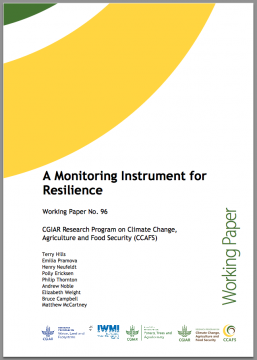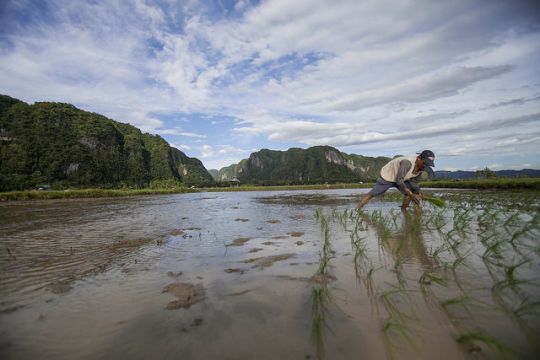New tool offers practitioners the opportunity to measure resilience and report impact


Implicit in all development work is the quest for impact. Positively influencing livelihoods, landscapes and ecosystems is the goal of our work. Effecting such changes is known to require long-term, collaborative efforts, yet many development interventions take place within limited timeframes and scopes.
This is where many development practitioners are faced with a conundrum: how to measure results, and satisfy donors’ and funders’ demand for impact reporting, when the typical three-year development project has long expired by the time impacts emerge?
One group of researchers from the CGIAR Research Program on Water, Land and Ecosystems; the CGIAR Research Program on Climate Change, Agriculture and Food Security; and the CGIAR Research Program on Forests, Trees and Agroforestry set out to develop a tool that would allow for measuring results as far along the chain of change as possible, but that wouldn’t place significant additional monitoring or administrative burdens on the project manager.
Measuring resilience
They explored the concept of resilience in the context of agriculture, making the basic assumption that an improvement in ecosystem resilience equals impact and will ultimately yield an improvement in human well-being. The result is a recently published tool, which enables implementers of development interventions to track and monitor any changes in resilience.
Along with changes to ecosystem services, the tool proposes two other ‘categories’ of project outcomes that underpin farm-level resilience: increasing capacity of people to adapt and enhanced livelihoods and farm functioning.
Terry Hills, lead author of the publication detailing the tool, explains: “The hazards that test the resilience of a system – for example the sudden flood that destroys a farmer’s crop – is unlikely to be experienced during the lifetime of a project. What you need to measure are the factors that underpin resilience, such as people’s capacity to adapt. If your project outcomes have positive effects on these factors, then you can talk about having achieved impact.”

A farmer planting rice in Pangkep, South Sulawesi, Indonesia. Photo by Tri Saputro for Center for International Forestry Research (CIFOR).
Working with limitation
The design of the tool was influenced by understanding the common restrictions of development projects, such as limited time and budgets, coupled with demand for exhaustive reporting on impact.
“In looking at results, we established a hierarchy of categories of project outcomes, dimensions of those categories and indicators that best represent changes in the dimensions,” says Hills. “This system allows implementers to both measure indicators that are specifically relevant to their context and to report aggregated global results in the form of the number of people whose resilience has improved.”
While thus satisfying funders’ demand for an easily understood impact metric, the tool also allows users to remain rigorous in reporting impact. Project implementers are encouraged to select the indicators most relevant to the change they are trying to achieve, a flexibility that makes the tool widely applicable. In addition, implementers can input data they have already collected, avoiding additional administrative burdens while maintaining scientific accuracy.
Challenges remain
This monitoring instrument has made great strides in grounding the occasionally lofty concept of resilience. In addition, it offers implementers of development interventions an opportunity to meet an ever-growing demand for impact reporting, without surpassing the scope typically allowed by a development project.
Yet challenges still remain, including the risk of misguided use of the tool. It might be possible to use this tool to artificially inflate the scope of the impact. Hills: “Could we for example use the instrument to argue that this blog post has improved the resilience of 7.2 billion people?”
While the instrument was designed to balance a rigorous framework with a high degree of flexibility, it should, like all such tools, be considered only a guiding document until a critical mass of users has trialed the instrument and provided feedback on how it can be improved. “Until tools like this one have been tested, refined and brought into more common use, the challenges of measuring and reporting changes to resilience will remain elusive for many of us,” concludes Hills.
Article by Marianne Gadeberg
Citation
Hills T, Pramova E, Neufeldt H, Ericksen P, Thornton P, Noble A, Weight E, Campbell B, McCartney M. 2015. A Monitoring Instrument for Resilience. CCAFS Working Paper no. 96. CGIAR Research Program on Climate Change, Agriculture and Food Security (CCAFS). Copenhagen, Denmark.
(0) Comments
There is no content